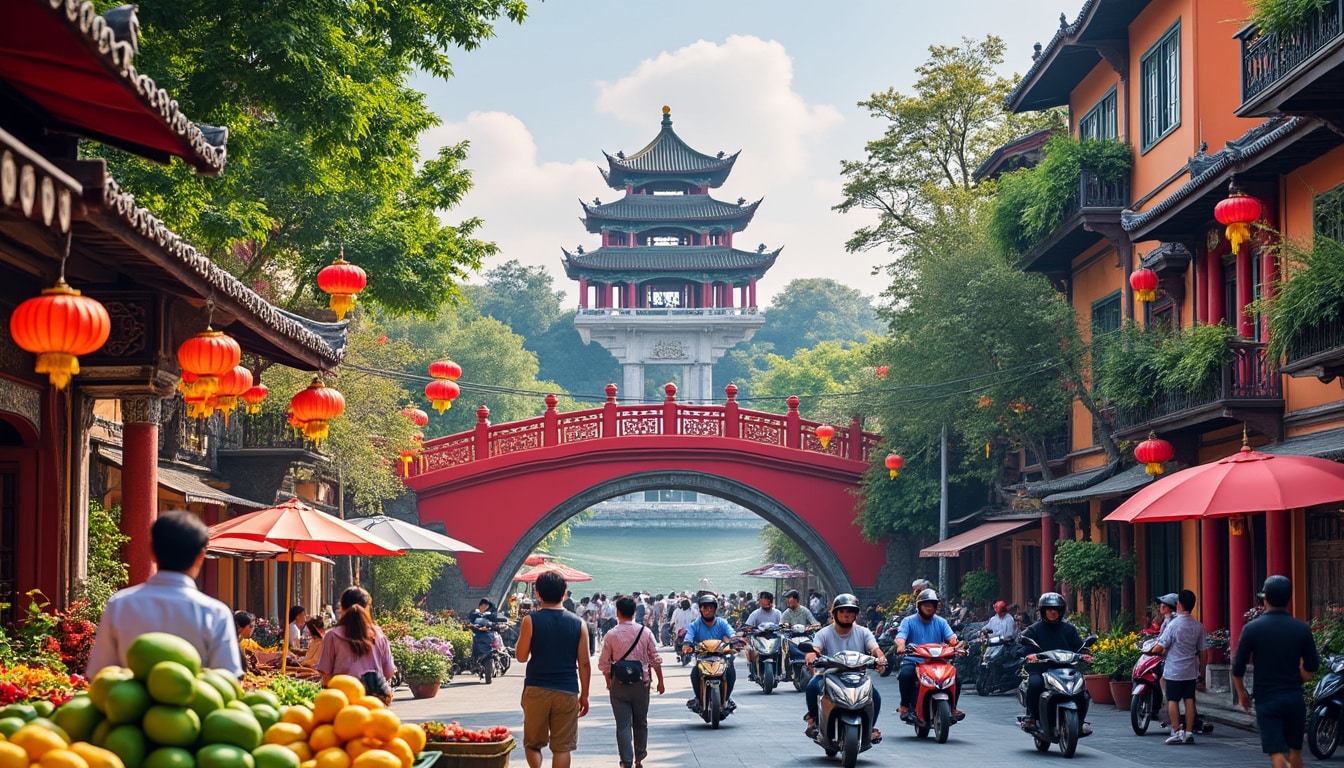Exploring Hanoi in 12 days offers an unparalleled opportunity to immerse oneself in a blend of history, culture, and modern vibrancy that this captivating city offers. From iconic landmarks steeped in history to charming neighborhoods bustling with life, Hanoi presents a unique travel experience. Whether it’s the aroma of pho from street vendors, the echoes of ancient dynasties, or the lively cultural dances, every corner of Hanoi is a story waiting to be discovered. This guide will navigate you through a carefully curated selection of must-see attractions, ensuring your time in Hanoi is as rich and memorable as the city itself.
Exploring the Historical Significance of Hoan Kiem Lake
Nestled in the heart of Hanoi, Hoan Kiem Lake serves as both a historical landmark and a hub of cultural activity. Known as the “Lake of the Returned Sword,” it is tied to the legend of Emperor Le Loi, who returned a magical sword to the Golden Turtle God here. This iconic lake is not only a peaceful retreat from Hanoi’s bustling life but also a focal point for local and tourist activities.

Visitors to Hoan Kiem Lake are greeted by the picturesque sight of the Turtle Tower, a small tower that adds to the lake’s mystical allure. In addition, the Red Huc Bridge connects the lake’s shore to the Ngoc Son Temple, another significant site that is dedicated to the war hero Tran Hung Dao. Walking around the lake, particularly in the morning, allows guests to observe locals practicing Tai Chi and other forms of exercise, contributing to the serene atmosphere that pervades this historical site.
- 🟢 Turtle Tower: An iconic structure seen in the middle of the lake, especially picturesque at sunrise and sunset.
- 🔴 Red Huc Bridge: A beautifully crafted wooden bridge painted in vibrant red, providing access to the Ngoc Son Temple.
- 🛕 Ngoc Son Temple: Dedicated to General Tran Hung Dao, this temple is an example of traditional Vietnamese architecture.
Beyond its historical significance, the area around Hoan Kiem Lake is lively with shops, cafes, and street performances, especially during weekends when the surrounding streets become pedestrian-only zones. This vibrant setting makes it ideal for visitors looking to experience a mix of Hanoi’s past and present in one stunning locale.
The Cultural Depths of Hanoi’s Old Quarter
One cannot truly experience Hanoi without venturing into the bustling lanes of the Old Quarter. This vibrant area, with its narrow streets and historic architecture, remains the city’s commercial and cultural heart.
The Old Quarter is known for its 36 guild streets, each traditionally dedicated to a particular trade, from weaving to medicine. Today, the streets buzz with a mix of old and new as traditional tailors rub shoulders with modern cafes and international restaurants. It’s a place where history meets the dynamic energy of a modern city, offering something unique at every corner.
The scent of street food fills the air—from steaming bowls of phở to the sweet aroma of Vietnamese coffee. Here, visitors can dine like locals at street-side stalls or explore vibrant markets such as the Dong Xuan Market, offering a glimpse into daily Vietnamese life.
- 🌮 Traditional street foods: Sample dishes like Bun Cha, Banh Mi, and pho prepared right in front of you.
- 🎨 Artisan goods: Handicrafts and embroidered textiles are widely available, reflecting the creativity and craftsmanship of the Vietnamese people.
- 📸 Photo opportunities: With its mix of French colonial architecture and lively street scenes, the Old Quarter is a photographer’s paradise.
Moreover, the Old Quarter hosts cultural events and night markets that are not to be missed. From art galleries to traditional music performances, every turn in the Old Quarter provides an opportunity to engage with Hanoi’s rich cultural tapestry.
Discovering the Spiritual and Cultural Heritage at the Temple of Literature
Hanoi’s Temple of Literature is more than just a historical site; it’s a symbol of Vietnam’s enduring reverence for learning and culture. Established in 1070, it served as Vietnam’s first national university, dedicated to Confucius, sages, and scholars.
The complex offers a serene escape from the city’s hustle, with its elegant courtyards and shaded pathways. The temple’s meticulously maintained gardens and ponds reflect the classical Chinese and Vietnamese architectural influences that define its structure.
Visitors to the Temple of Literature can wander through its various pavilions and courtyards, each with its own distinctive features. The Stelae of Doctors, large stone tablets inscribed with the names of those who passed the royal exams, are particularly remarkable, offering insight into the academic rigor of historical Vietnam.
- 📜 Stelae of Doctors: These stone monuments commemorate scholars and are seen as symbols of intellectual achievement.
- 🧘♀️ Quiet meditation: The tranquil environment is perfect for reflection, with benches scattered throughout the grounds.
- 🏛️ Architectural beauty: The harmonious blend of trees, traditional Vietnamese design, and serene water features offers a peaceful retreat.
The Temple of Literature frequently hosts cultural events that showcase traditional music and art, providing visitors a fuller experience of Vietnamese cultural heritage. As a site of historical and educational significance, it remains a must-see for those eager to delve deeper into Vietnam’s rich tapestry of history and learning.
One Pillar Pagoda: Icon of Architectural Wonders
The One Pillar Pagoda, an iconic symbol of Hanoi, stands as a testament to the city’s architectural and cultural ingenuity. Constructed in 1049, its distinctive design of a wooden structure perched on a single stone pillar symbolizes purity, peace, and the unique artistic style of the era.
Visitors to the pagoda are often struck by its serene setting within a lotus pond, itself a symbol of enlightenment in Buddhist culture. This iconic landmark, despite its modest size, holds a profound place in the hearts of Vietnamese people and offers a glimpse into the spiritual life in Hanoi.
| Feature | Details | Significance 🌟 |
|---|---|---|
| Construction | Built in 1049 | Representative of Ly Dynasty architecture |
| Design | Wooden pagoda on a single stone pillar | Symbolizes purity and enlightenment |
| Setting | Within a lotus pond | Spiritual significance in Buddhism |
While small, the pagoda is a profound reminder of the city’s historical depth and cultural identity, making it a must-visit for those intrigued by the spiritual dimensions of Hanoi.
Engaging with Hanoi’s Modern History at Hoa Lo Prison
.
Distinguished by its turbulent history, Hoa Lo Prison, often referred to as the “Hanoi Hilton,” is a site of both reflection and education. Originally constructed by the French to detain Vietnamese political prisoners, it played a significant role during the Vietnam War as well.
Today, Hoa Lo functions as a museum, showcasing artifacts and exhibits that highlight the resilience and struggles of the Vietnamese people. Through guided tours and interactive displays, visitors can explore the stories of those who were imprisoned here and gain insight into Vietnam’s quest for independence.
- ⛓️ Stories of resilience: Learn about the Vietnamese revolutionaries who endured captivity within its walls.
- 📜 Historical narratives: Discover artifacts and first-hand accounts from both the French colonial period and the Vietnam War.
- 🏛️ Interactive exhibits: Gain a deeper understanding of the prison’s role in Vietnam’s history through detailed displays and reconstructions.
Hoa Lo Prison remains a poignant reminder of Vietnam’s complex past, inviting visitors to reflect on the courage and resilience that shaped the nation’s history.
As you explore Hanoi, from its bustling streets to tranquil lakes, you will uncover the layers of history, culture, and modernity that define this incredible city.
Frequently Asked Questions about Hanoi
- What is the best time to visit Hanoi? 🕒
- How do I get around in Hanoi? 🚲
- Where can I find accommodation in Hanoi? 🏨
- What are some must-try foods in Hanoi? 🍜
- Is it safe for tourists in Hanoi? ⚠️

